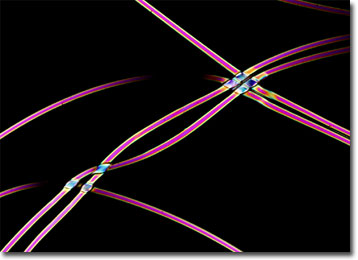Polarized Light Microscopy Digital Image Gallery
Nylon Fibers
Nylons were developed by a research team supported by E.I. du Pont de Nemours & Company, Inc. in the 1930s. The substantial achievements of the group inspired a significant amount of additional research on polymers, resulting in a rapid increase in the number of synthetic fibers available.

View a second image of Nylon Fibers
Nylons are composed of polymers containing repeated amide groups called polyamides that have a high molecular weight. When produced as fibers, nylons are elastic and strong. If these fibers are stretched into fine filaments, they become lustrous and can be spun into a material that is similar to silk. It is in this form, which has been commonly utilized in hosiery since the 1940s, that nylons are perhaps most familiar. In addition to their luxurious appearance, fine nylon materials have a low moisture absorbency and are resistant to mold, mildew, chemicals, and abrasion.
Due to their many excellent characteristics, nylons are not only manufactured as fibers, but also as powders, sheets, sprays, and coatings, greatly expanding their practical usage. However, many people are less familiar with such various forms of nylons because they are often marketed under a variety of trade names, such as Kevlar, Orlon, and Caprolan. Some of the less well-known products that are frequently composed of nylons include tires, wire casings, netting, bearings, and rope.
